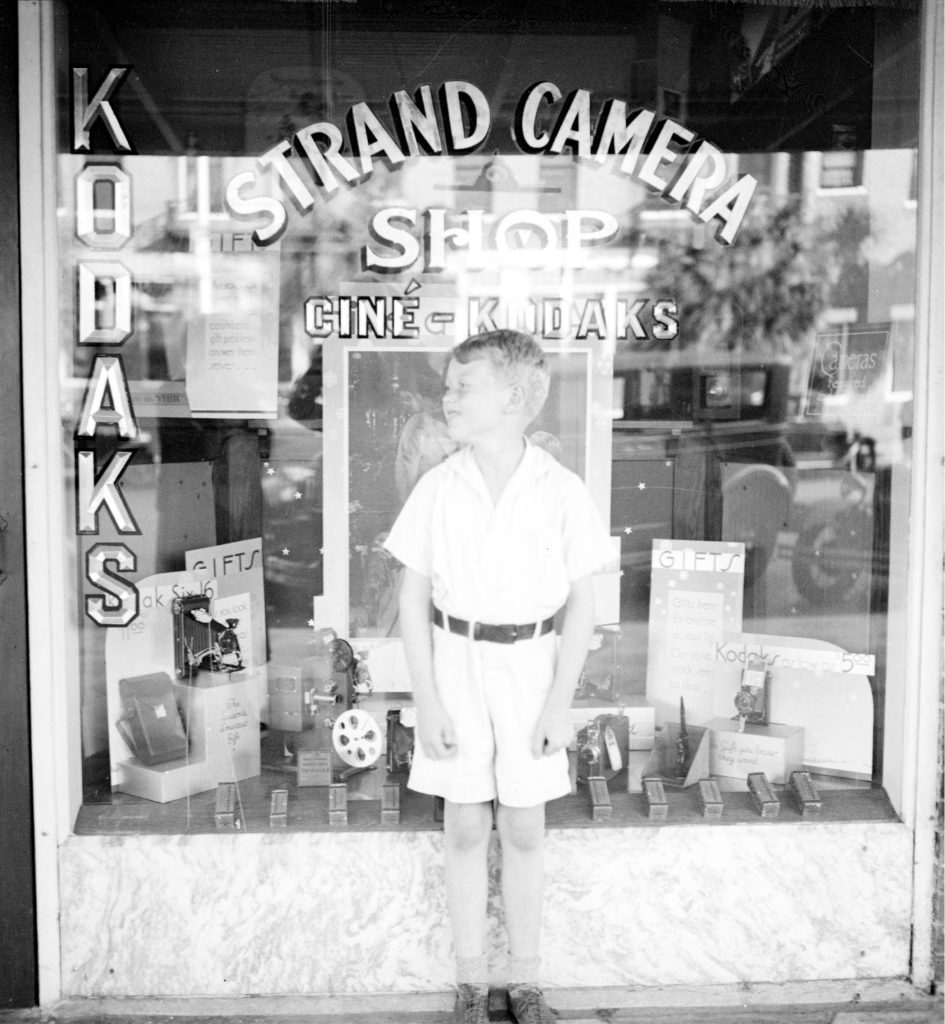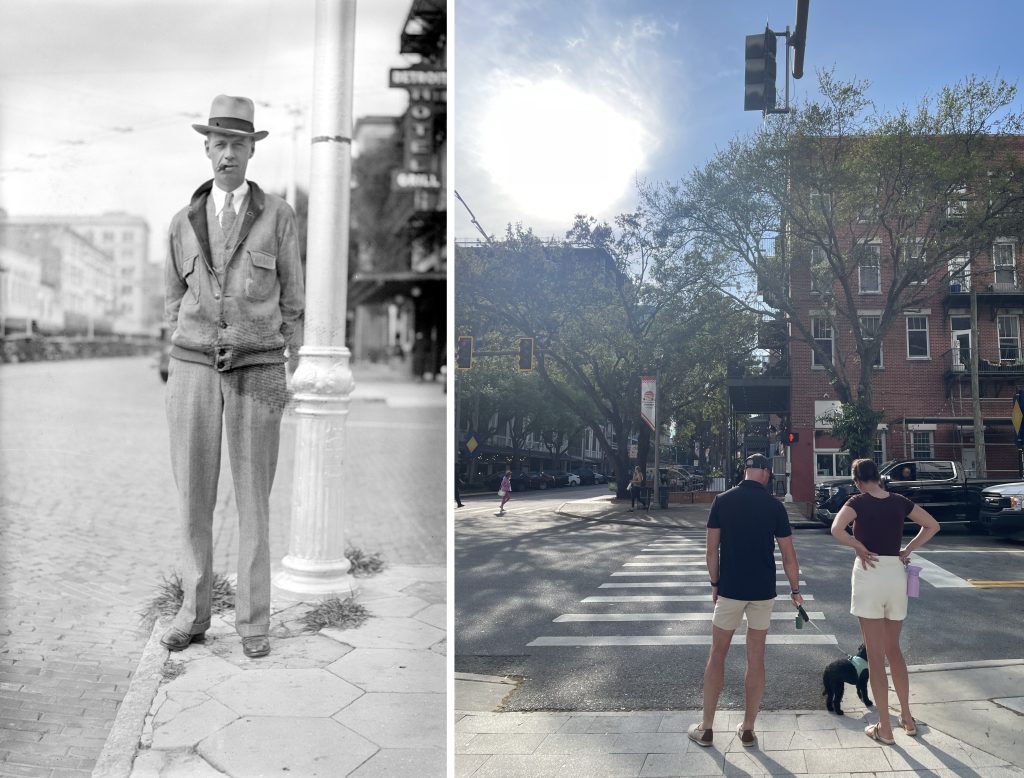This post was guest authored by Alexandra Vargas-Minor, Florida Studies Curator & Campus Archivist at the Nelson Poynter Memorial Library, USF Libraries – St. Petersburg campus.
As the incoming Florida Studies Curator & Campus Archivist at the Nelson Poynter Memorial Library, I’ve been immersing myself in the Special Collections & University Archives department’s collections and the history of St. Petersburg as a whole. One collection that I have relied on in these pursuits is the Francis G. Wagner Collection of St. Petersburg Photographs. The Wagner Collection came to the Poynter Library via Earl R. Jacobs, III, who found more than 900 photographic negatives while cleaning a storage loft located at 9 Second Street North in 1984. The negatives were remnants from St. Petersburg’s first camera store, Strand Camera Shop, founded in 1916 by Detroit photographer Francis G. Wagner (1891-1975). The photographs in the Wagner Collection offer a glimpse into early 20th century St. Petersburg’s landscape and lifestyle, depicting notable landmarks around town, recreational activities, and the domestic life of early St. Petersburg residents.
After attending Peter Belmont’s historic walking tour of downtown St. Petersburg through Preserve the ‘Burg, it dawned on me that many of the landmarks on the tour were photographed in the Wagner collection. This inspired me to take my own walking tour of downtown using the Wagner Photograph Collection as my guide.


Right: Vargas-Minor, A. Photograph of Central Avenue and 2nd Street North with unidentified couple and dog, St. Petersburg, FL (March 14, 2024).
Next stop on my route was the site of the old Floronton Hotel, located one block north at the intersection of 1st Avenue Northeast and 2nd Street North. The Floronton Hotel was St. Petersburg’s first all-masonry hotel and was repurposed as an Army Air Corps facility in WWII, then the Toffenetti and Tropicana Hotels, and finally as office spaces for the Bay Plaza Corporation.[2] The Floronton Hotel building survived until the ONE St. Petersburg condominiums were built and opened in 2018. After doing more research I realized the photo I took (below, right) may actually of the back of the Floronton Hotel site, but it still gives you an idea of what the site looks like today.

Right: Vargas-Minor, A. Photograph of Hyatt Place St. Petersburg/Downtown (center) and ONE Condominiums (background, left), 25 2nd St. N., St. Petersburg, FL (March 14, 2024).
After visiting the sites on 2nd Street North, I set my course towards the Williams Park area, walking west on 1st Avenue North until reaching the Open Air Post Office at the 4th Street North intersection. The Open Air Post Office is a beautiful Mediterranean revival building and is a perfect example of how a historic building was adapted to modern life. Designed by Postmaster Roy S. Hannah and architect George W. Stuart, the Open Air Post Office began operation in 1916. The building’s interior chamber was enclosed in 1969 to install air conditioning, indoor service counters, and additional postal boxes.[3] I love all of the ornamentation on the building’s façade and am so impressed at how well the building has been maintained over the last 100 years.

Right: Vargas-Minor, A. Photograph of the Open Air Post Office, 400 1st Ave. N., St. Petersburg, FL (March 14, 2024).
Directly north of the Open Air Post Office is the Princess Martha Hotel, a fantastic example of adaptive reuse of a historic building. Designed in the Neoclassical style by Franklin Mason and supervising architect Frank Jonsberg, the Mason Hotel came to fruition in 1924 and was the first hotel in St. Petersburg to be financed through the sale of public stock. It was later sold to William Muir and was renamed Princess Martha after his wife Martha.[4] Having transformed its hotel rooms into one-and two-bedroom apartments, the Princess Martha is now an affordable Senior Living Community with the fully restored entrance lobby and ballroom.[5] I did not attempt looking inside the building, but I would love to tour the restored parts of the Princess Martha one day!

Left: “Princess Martha Hotel from 1st Avenue North and Williams Park. Suwannee Hotel in background. Busy street scene with cars and people, man sitting on bench.” (January 1926). Francis G. Wagner St. Petersburg Photographs Collection. Image 577. https://digitalcommons.usf.edu/wagner/577/
Right: Vargas-Minor, A. Photograph of Princess Martha Hotel, 411 1st Ave. N., St. Petersburg, FL (March 14, 2024).
To the east of the Princess Martha Hotel and across 4th Street South is Williams Park, home of the Williams Park Bandshell. The fist bandshell was erected in 1895 and moved to Waterfront Park where it was destroyed by a hurricane in 1921. The second bandshell, which is featured in the Wagner Photograph collection (image below, left), was constructed by contractor John S. Silas in 1920. The third and current bandshell (image below, right) was designed and erected by architect William Harvard, Sr., in 1953. Though the avant-garde design of the structure was controversial within the community, Harvard’s design received national awards from the American Institute of Architects and the Florida Association of the American Institute of Architects.[6] After making a quick visit to Localtopia earlier in the month, I love that the bandshell is still actively used as a venue and community gathering spot.

Right: Vargas-Minor, A. Photograph of the Williams Park Bandshell with the First United Methodist Church behind trees on the right, 320 2nd Avenue North, Petersburg, FL (March 14, 2024).
The last stop on my self-guided walking tour was the First United Methodist Church, located directly north of the Williams Park Bandshell on the southeast corner of 2nd Avenue North and 3rd Street North. Designed and built in 1925 by James Baldwin, the Gothic Revival and English Gothic-style church building was the third church structure erected on this corner thanks to the growth of the congregation.[7] This building is an impressively towering structure, and its final iteration is a reminder of how institutions within the city had to expand to accommodate their growing community.

Right: Vargas-Minor, A. Photograph of the First United Methodist Church, 212 3rd Street North, St. Petersburg, FL (March 14, 2024).
As my self-guided walking adventure came to an end, I reflected on downtown’s St. Petersburg’s evolution in the last century. Walking around visiting these historic landmarks made me realize just how dedicated the St. Petersburg community is to preserving its history. Juxtaposing these historic structures with newer neighboring buildings and condominiums demonstrates to how impactful these local preservation efforts have been, and yet reminds us of how easy it is to demolish and forget our history. As Peter Belmont posited to the group at the end of his Preserve the ‘Burg walking tour, I was left wondering about the future of St. Petersburg’s historic preservation efforts and at what point the newer buildings and condominiums will be in need of their own preservation efforts.
REFERENCES
[1] Nelson Poynter Memorial Library. (n.d.) Francis G. Wagner’s St. Petersburg Photographs. Digital Commons @ University of South Florida. https://digitalcommons.usf.edu/wagner/
[2] Kneeshaw, L. (2020, June 2). 11 we lost: Building St. Pete should have saved. Preserve the ‘Burg. https://www.preservetheburg.org/blog/building-st-pete-should-have-saved
[3] Green Bench Monthly. (2018, August 18). History breezes through the Open Air Post Office. Green Bench Monthly: St. Pete’s Community Magazine. https://greenbenchmonthly.com/st-petersburg-history/history-breezes-through-the-open-air-post-office/
[4] Michaels, W. (2012). The making of St. Petersburg (p. 142). The History Press.
[5] The Princess Martha. (n.d.). History: From a luxury winter resort to a Senior Living Community. The Princess Martha. https://theprincessmartha.com/amenities-and-services/history/
[6] Michaels, 2012, p. 56.
[7] Breslauer, K. (2011). Historic sites and architecture of St. Petersburg Florida (p. 19). Outskirts Press, Inc.